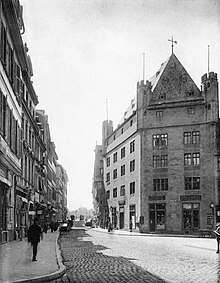Johann von Holzhausen
Johann von Holzhausen (* unknown, before 1343 ; † February 7, 1393 in Frankfurt am Main ) was a councilor and mayor in Frankfurt am Main.
The year of birth of Johann von Holzhausen is not known, his name was first mentioned in documents in 1354, when the Count zu Hochstadt enfeoffed him with a share of his tax income. His parents were Gipel Holzhausen (* before 1306; † before 1355) and Katharina zum Wedel († before 1343).
The Holzhausen family had lived in Frankfurt am Main since the middle of the 13th century. She came from Burgholzhausen vor der Höhe (today a district of Friedrichsdorf ) and was one of the most important patrician families in Frankfurt. She was one of ganerbschaft Old Limpurg at which since the 14th century dominated the City Council. Around 30 members of the family provided one of the two mayors of the city a total of around 70 times, as well as city councils and envoys at the Reichstag and city days .
Johann von Holzhausen married Guda Goldstein (* unknown; † December 3, 1371 ) in 1357 , with whom he had two sons and two daughters in 14 years of marriage. In the same year he was already councilor and younger mayor, 1363 aldermen and 1364 senior mayor of Frankfurt. In 1363 he built the Fürsteneck house on Fahrgasse, which was one of the few representative stone buildings in Frankfurt's old town until it was destroyed in the Second World War in 1944 .
In the 1360s he was involved in the suppression of an uprising of the guilds that broke out in 1355 through domestic political skills . a. After his election as Senior Mayor in 1364, he urged the younger Mayor Henne Wirbel, who actually acted as a people's leader, out of office. In 1366 it finally succeeded in the Reichsschultheißenamt from the pledge of Ulrich III. von Hanau , who had supported the rebels, and entrusting the Frankfurt patrician Siegfried zum Paradies with it. All concessions previously made to the guilds were immediately withdrawn.
Furthermore, in May 1372 he was part of an embassy that Emperor Charles IV visited in Mainz and was able to negotiate for a sum of 8,800 guilders that the office pledged and pledged this sum to lay judges, mayors, citizens and the city council of Frankfurt am Main thus was raised to the Free Imperial City . Johann von Holzhausen thus played a significant role in the enforcement of patriciate supremacy, which existed from then until the end of the Holy Roman Empire (1806).
His tomb and that of his wife have been in the north transept of Frankfurt Cathedral since 1830 . Before that, it stood for over four centuries in the Gothic St. Michael's Chapel, which was demolished in 1829, in the cathedral cemetery.
literature
- Wolfgang Klötzer (Hrsg.): Frankfurter Biographie . Personal history lexicon . First volume. A – L (= publications of the Frankfurt Historical Commission . Volume XIX , no. 1 ). Waldemar Kramer, Frankfurt am Main 1994, ISBN 3-7829-0444-3 .
- Hans Körner, Andreas Hansert: Frankfurt patricians. Historical-genealogical manual of the aristocratic inheritance of the Alten-Limpurg house in Frankfurt am Main , Degener & Co publishing house, Neustadt an der Aisch 2003, ISBN 3-7686-5177-0 .
- Franz Lerner: Figures from the history of the Frankfurt patrician family von Holzhausen , Verlag Waldemar Kramer, Frankfurt am Main 1953.
| personal data | |
|---|---|
| SURNAME | Holzhausen, Johann von |
| BRIEF DESCRIPTION | Councilor and Mayor in Frankfurt am Main |
| DATE OF BIRTH | before 1343 |
| DATE OF DEATH | February 7, 1393 |
| Place of death | Frankfurt am Main |

